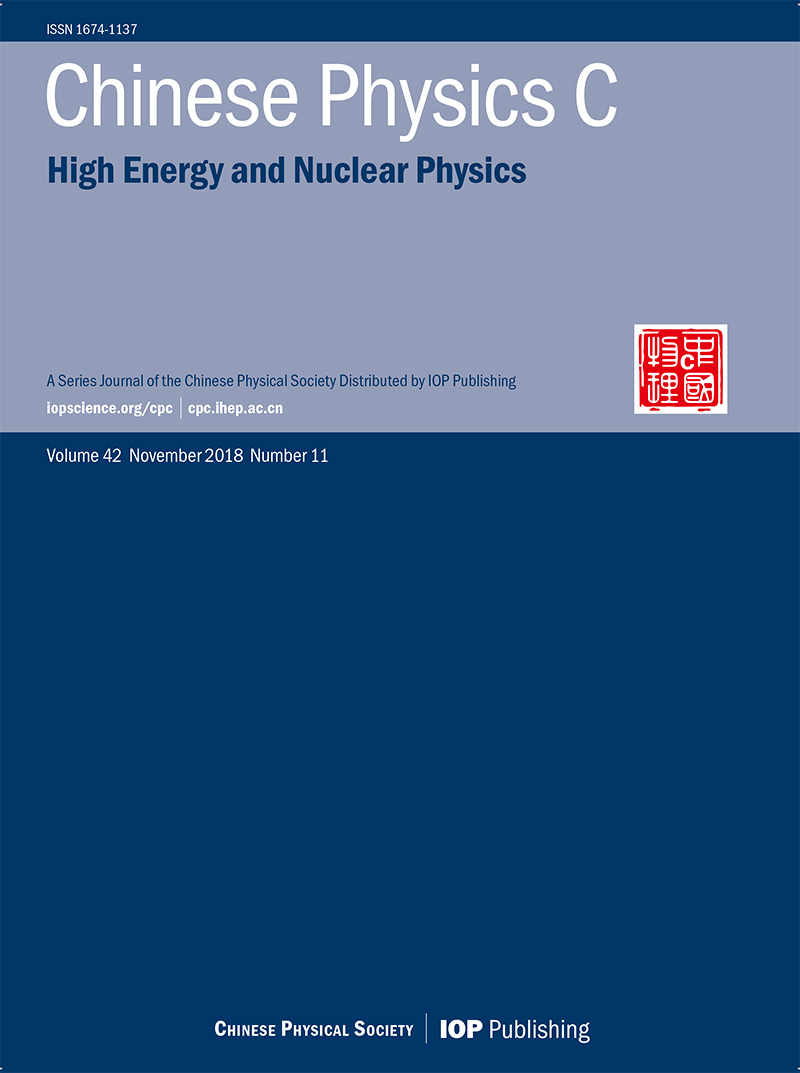2021 Vol. 45, No. 11
Display Method: |
2021, 45(11): 112001. doi: 10.1088/1674-1137/ac2049
Abstract:
Understanding the thermodynamic phase transition of black holes can provide a deep insight into the fundamental properties of black hole gravity to establish the theory of quantum gravity. We investigate the condition and latent heat of phase transition for non-linear charged AdS black holes using Maxwell's equal-area law. In addition, we analyze the boundary and curve of the two-phase coexistence area in the expanded phase space. We suggest that the phase transition of the non-linear charged AdS black hole with the fixed temperature (\begin{document}$ T<T_{\rm c} $\end{document} ![]()
![]()
Understanding the thermodynamic phase transition of black holes can provide a deep insight into the fundamental properties of black hole gravity to establish the theory of quantum gravity. We investigate the condition and latent heat of phase transition for non-linear charged AdS black holes using Maxwell's equal-area law. In addition, we analyze the boundary and curve of the two-phase coexistence area in the expanded phase space. We suggest that the phase transition of the non-linear charged AdS black hole with the fixed temperature (
2021, 45(11): 113101. doi: 10.1088/1674-1137/ac1b9a
Abstract:
The one-loop contributions to the chromomagnetic dipole moment\begin{document}$\hat\mu_t(q^2)$\end{document} ![]()
![]()
\begin{document}$\hat d_t(q^2)$\end{document} ![]()
![]()
\begin{document}$q^2$\end{document} ![]()
![]()
\begin{document}$\hat \mu_t(q^2)$\end{document} ![]()
![]()
\begin{document}$Z'$\end{document} ![]()
![]()
\begin{document}$V^\pm$\end{document} ![]()
![]()
\begin{document}$h_2$\end{document} ![]()
![]()
\begin{document}$Z'$\end{document} ![]()
![]()
\begin{document}$h_2$\end{document} ![]()
![]()
\begin{document}$\hat d_t(q^2)$\end{document} ![]()
![]()
\begin{document}$CP$\end{document} ![]()
![]()
\begin{document}$\hat\mu_t(q^2)$\end{document} ![]()
![]()
\begin{document}$\hat d_t(q^2)$\end{document} ![]()
![]()
\begin{document}$\hat \mu_t(q^2)$\end{document} ![]()
![]()
\begin{document}$10^{-5}$\end{document} ![]()
![]()
\begin{document}$10^{-6}$\end{document} ![]()
![]()
\begin{document}$V^\pm$\end{document} ![]()
![]()
\begin{document}$\|q\|$\end{document} ![]()
![]()
\begin{document}$m_{V}$\end{document} ![]()
![]()
\begin{document}$\hat d_t(q^2)$\end{document} ![]()
![]()
\begin{document}$h_2$\end{document} ![]()
![]()
\begin{document}$10^{-19}$\end{document} ![]()
![]()
The one-loop contributions to the chromomagnetic dipole moment
2021, 45(11): 113102. doi: 10.1088/1674-1137/ac1bfd
Abstract:
In this study, we calculate the\begin{document}$t\bar{t}$\end{document} ![]()
![]()
\begin{document}$\sqrt{S}=13$\end{document} ![]()
![]()
\begin{document}$\beta$\end{document} ![]()
![]()
\begin{document}$t\bar{t}$\end{document} ![]()
![]()
\begin{document}$m_t^{\rm{pole}}=172.5\pm1.4$\end{document} ![]()
![]()
\begin{document}$\sqrt{S}=13$\end{document} ![]()
![]()
\begin{document}$\sqrt{S}=13$\end{document} ![]()
![]()
In this study, we calculate the
2021, 45(11): 113103. doi: 10.1088/1674-1137/ac1c66
Abstract:
Without contamination from the final state interactions, the calculation of the branching ratios of semileptonic decays\begin{document}$ \Xi^{(')}_{c}\to\Xi+e^+\nu_e $\end{document} ![]()
![]()
\begin{document}$ \Xi_c\to\Xi $\end{document} ![]()
![]()
\begin{document}$ \Xi_c $\end{document} ![]()
![]()
\begin{document}$ \Xi $\end{document} ![]()
![]()
\begin{document}$ \beta_{s[sq]} = 1.07 $\end{document} ![]()
![]()
\begin{document}$ \beta_{s\bar s} = 0.366 $\end{document} ![]()
![]()
\begin{document}$ ss $\end{document} ![]()
![]()
\begin{document}$ \Xi $\end{document} ![]()
![]()
\begin{document}$ \Xi^{(')}_c\to \Xi $\end{document} ![]()
![]()
Without contamination from the final state interactions, the calculation of the branching ratios of semileptonic decays
2021, 45(11): 113104. doi: 10.1088/1674-1137/ac1e09
Abstract:
In this study, we investigated the cosmological implications of a complex singlet scalar\begin{document}$ {\cal{S}}$\end{document} ![]()
![]()
\begin{document}$ B-L$\end{document} ![]()
![]()
\begin{document}$ U(1)_{B-L}$\end{document} ![]()
![]()
\begin{document}$ {\cal{S}}$\end{document} ![]()
![]()
\begin{document}$ {\cal{S}}$\end{document} ![]()
![]()
In this study, we investigated the cosmological implications of a complex singlet scalar
2021, 45(11): 113105. doi: 10.1088/1674-1137/ac1ef9
Abstract:
We apply an equal-velocity quark combination model to study the production of light-flavor hadrons and single-charmed hadrons at midrapidity in the\begin{document}$ pp $\end{document} ![]()
![]()
\begin{document}$ \sqrt{s} = 5.02 $\end{document} ![]()
![]()
\begin{document}$ p_{T} $\end{document} ![]()
![]()
\begin{document}$ \Omega $\end{document} ![]()
![]()
\begin{document}$ \phi $\end{document} ![]()
![]()
\begin{document}$ p_T $\end{document} ![]()
![]()
\begin{document}$ p $\end{document} ![]()
![]()
\begin{document}$ \Lambda $\end{document} ![]()
![]()
\begin{document}$ \Xi $\end{document} ![]()
![]()
\begin{document}$ \Omega $\end{document} ![]()
![]()
\begin{document}$ \phi $\end{document} ![]()
![]()
\begin{document}$ K^{*0} $\end{document} ![]()
![]()
\begin{document}$ p_{T} $\end{document} ![]()
![]()
\begin{document}$ \Omega/\phi $\end{document} ![]()
![]()
\begin{document}$ p_{T} $\end{document} ![]()
![]()
\begin{document}$ p_{T} $\end{document} ![]()
![]()
\begin{document}$ p_T $\end{document} ![]()
![]()
\begin{document}$ D^{0,+} $\end{document} ![]()
![]()
\begin{document}$ D_{s}^{+} $\end{document} ![]()
![]()
\begin{document}$ \Lambda_{c}^{+} $\end{document} ![]()
![]()
\begin{document}$ p_{T} $\end{document} ![]()
![]()
\begin{document}$ \Xi_{c}^{0,+} $\end{document} ![]()
![]()
\begin{document}$ \Omega_{c}^{0} $\end{document} ![]()
![]()
\begin{document}$ \Xi_{c}^{0,+}/D^{0} $\end{document} ![]()
![]()
\begin{document}$ \Omega_{c}^{0}/D^{0} $\end{document} ![]()
![]()
\begin{document}$ \Xi_{c}^{0,+}/D^{0} $\end{document} ![]()
![]()
\begin{document}$ \Omega_{c}^{0}/D^{0} $\end{document} ![]()
![]()
\begin{document}$ p_{T} $\end{document} ![]()
![]()
\begin{document}$ p_{T} $\end{document} ![]()
![]()
We apply an equal-velocity quark combination model to study the production of light-flavor hadrons and single-charmed hadrons at midrapidity in the
2021, 45(11): 113106. doi: 10.1088/1674-1137/ac21b8
Abstract:
We calculate the\begin{document}$D\to P$\end{document} ![]()
![]()
\begin{document}$R_{SU(3)}^{+,0}=1.12$\end{document} ![]()
![]()
\begin{document}$R_{SU(3)}^{T}=1.39$\end{document} ![]()
![]()
\begin{document}$\phi_D^+(\omega, \mu)$\end{document} ![]()
![]()
\begin{document}$|V_{cd}|=0.151\,{}^{+0.091}_{-0.043} \big |_{\rm th.}\,{}^{+0.017}_{-0.02} \big |_{\rm exp.}$\end{document} ![]()
![]()
\begin{document}$|V_{cs}|=0.89\,{}^{+0.467}_{-0.234} \big |_{\rm th.}\,{}^{+0.008}_{-0.008} \big |_{\rm exp.}$\end{document} ![]()
![]()
We calculate the
2021, 45(11): 113107. doi: 10.1088/1674-1137/ac224b
Abstract:
The strong coupling constants are basic quantities that carry information on the strong interactions among the baryon and meson multiplets as well as information on the nature and internal structures of the involved hadrons. These parameters are introduced in the transition matrix elements of various decays as main inputs and play key roles in analyses of experimental data including various hadrons. We derive the strong coupling constants among the doubly heavy spin-\begin{document}$ 3/2 $\end{document} ![]()
![]()
\begin{document}$\Xi^*_{QQ'} $\end{document} ![]()
![]()
\begin{document}$\Omega^*_{QQ'}$\end{document} ![]()
![]()
The strong coupling constants are basic quantities that carry information on the strong interactions among the baryon and meson multiplets as well as information on the nature and internal structures of the involved hadrons. These parameters are introduced in the transition matrix elements of various decays as main inputs and play key roles in analyses of experimental data including various hadrons. We derive the strong coupling constants among the doubly heavy spin-
2021, 45(11): 114101. doi: 10.1088/1674-1137/ac1c67
Abstract:
The matrix elements along the reduction chain Sp(12,R)\begin{document}$ \supset $\end{document} ![]()
![]()
\begin{document}$ \otimes $\end{document} ![]()
![]()
\begin{document}$ \supset $\end{document} ![]()
![]()
\begin{document}$ \otimes $\end{document} ![]()
![]()
\begin{document}$ _{pn} $\end{document} ![]()
![]()
\begin{document}$ \otimes $\end{document} ![]()
![]()
\begin{document}$ \supset $\end{document} ![]()
![]()
The matrix elements along the reduction chain Sp(12,R)
2021, 45(11): 114102. doi: 10.1088/1674-1137/ac1d9c
Abstract:
A strong background field drastically changes the vacuum structure and proper basis of a system in both classical and quantum mechanics, e.g., the Landau levels in a background magnetic field. This is true even for a rotating system. In such a system, the usual set of plane-wave states would no longer be suitable as a starting point of perturbation. Alternatively and straightforwardly, in a rapidly and globally rotating system, it is better to reformulate the perturbation computation in principle. In this study, we completed the first step for the spin-1 field, which includes solving the Proca equation in the presence of a background rotation and completing its canonical quantization. We show that because of the symmetry, the eigen states are actually the same as those of Maxwell equations in cylindrical coordinates. The propagator as well as the near-central approximation were obtained by assuming that the vorticity areas are very small in the relativistic QGP.
A strong background field drastically changes the vacuum structure and proper basis of a system in both classical and quantum mechanics, e.g., the Landau levels in a background magnetic field. This is true even for a rotating system. In such a system, the usual set of plane-wave states would no longer be suitable as a starting point of perturbation. Alternatively and straightforwardly, in a rapidly and globally rotating system, it is better to reformulate the perturbation computation in principle. In this study, we completed the first step for the spin-1 field, which includes solving the Proca equation in the presence of a background rotation and completing its canonical quantization. We show that because of the symmetry, the eigen states are actually the same as those of Maxwell equations in cylindrical coordinates. The propagator as well as the near-central approximation were obtained by assuming that the vorticity areas are very small in the relativistic QGP.
2021, 45(11): 114103. doi: 10.1088/1674-1137/ac1fe1
Abstract:
The elastic-scattering angular distributions and total reaction cross sections of\begin{document}$^{9,10,11,13,14}{\rm{C}}$\end{document} ![]()
![]()
\begin{document}$^{12}{\rm{C}}$\end{document} ![]()
![]()
\begin{document}$^{9}{\rm{Be}}$\end{document} ![]()
![]()
\begin{document}$^{12}{\rm{C}}$\end{document} ![]()
![]()
\begin{document}$^{9}{\rm{Be}}$\end{document} ![]()
![]()
\begin{document}$^{9,10,11,13}{\rm{C}}$\end{document} ![]()
![]()
\begin{document}$^{14}{\rm{C}}$\end{document} ![]()
![]()
\begin{document}$^{12}{\rm{C}}$\end{document} ![]()
![]()
The elastic-scattering angular distributions and total reaction cross sections of
2021, 45(11): 114104. doi: 10.1088/1674-1137/ac2298
Abstract:
The scission point model is improved by considering the excitation-dependent liquid drop model to calculate mass distributions for neutron-induced actinide nuclei fission. Excitation energy effects influence the deformations of light and heavy fragments. The improved scission point model shows a significant advance with regard to accuracy for calculating pre-neutron-emission mass distributions of neutron-induced typical actinide fission with incident-neutron-energies up to 99.5 MeV. The theoretical frame assures that the improved scission point model is suitable for evaluating the fission fragment mass distributions, which will provide guidance for studying fission physics and designing nuclear fission engineering and nuclear transmutation systems.
The scission point model is improved by considering the excitation-dependent liquid drop model to calculate mass distributions for neutron-induced actinide nuclei fission. Excitation energy effects influence the deformations of light and heavy fragments. The improved scission point model shows a significant advance with regard to accuracy for calculating pre-neutron-emission mass distributions of neutron-induced typical actinide fission with incident-neutron-energies up to 99.5 MeV. The theoretical frame assures that the improved scission point model is suitable for evaluating the fission fragment mass distributions, which will provide guidance for studying fission physics and designing nuclear fission engineering and nuclear transmutation systems.
2021, 45(11): 115101. doi: 10.1088/1674-1137/ac1c65
Abstract:
Supernova remnants are supposed to be the most possible sources of cosmic rays. However, alternative sources of cosmic rays, such as an active galactic nucleus, gamma-ray bursts, and pulsars, have not be excluded. In this study, we investigate the possibility of cosmic rays being generated by pulsars. The pulsar is simply described as a rotational magnetic dipole, the so-called Hertzian magnetic dipole, an exact solution of the d'Alembert equations. In the rotational magnetic dipole field, charged particles experience an accelerated electric field with their radiation reaction. The particles, which are initially static out of the light cylinder radius, can be accelerated up to a high energy.
Supernova remnants are supposed to be the most possible sources of cosmic rays. However, alternative sources of cosmic rays, such as an active galactic nucleus, gamma-ray bursts, and pulsars, have not be excluded. In this study, we investigate the possibility of cosmic rays being generated by pulsars. The pulsar is simply described as a rotational magnetic dipole, the so-called Hertzian magnetic dipole, an exact solution of the d'Alembert equations. In the rotational magnetic dipole field, charged particles experience an accelerated electric field with their radiation reaction. The particles, which are initially static out of the light cylinder radius, can be accelerated up to a high energy.
2021, 45(11): 115102. doi: 10.1088/1674-1137/ac1e83
Abstract:
Recently, a de-Sitter epoch has been found in the new model of loop quantum cosmology, which is governed by the scalar constraint with both Euclidean and Lorentz terms. The singularity free bounce in the new LQC model and the emergent cosmology constant strongly suggest that the effective stress-energy tensor induced by quantum corrections must violate the standard energy conditions. In this study, we perform an explicit calculation to analyze the behaviors of specific representative energy conditions, i.e., average null, strong, and dominant energy conditions. We reveal that the average null energy condition is violated at all times, while the dominant energy condition is violated only at a period around the bounce point. The strong energy condition is violated not only at a period around the bounce point but also in the whole period from the bounce point to the classical phase corresponding to the de Sitter period. Our results will shed some light on the construction of a wormhole and time machine, which usually require exotic matter to violate energy conditions.
Recently, a de-Sitter epoch has been found in the new model of loop quantum cosmology, which is governed by the scalar constraint with both Euclidean and Lorentz terms. The singularity free bounce in the new LQC model and the emergent cosmology constant strongly suggest that the effective stress-energy tensor induced by quantum corrections must violate the standard energy conditions. In this study, we perform an explicit calculation to analyze the behaviors of specific representative energy conditions, i.e., average null, strong, and dominant energy conditions. We reveal that the average null energy condition is violated at all times, while the dominant energy condition is violated only at a period around the bounce point. The strong energy condition is violated not only at a period around the bounce point but also in the whole period from the bounce point to the classical phase corresponding to the de Sitter period. Our results will shed some light on the construction of a wormhole and time machine, which usually require exotic matter to violate energy conditions.
ISSN 1674-1137 CN 11-5641/O4
Original research articles, Ietters and reviews Covering theory and experiments in the fieids of
- Particle physics
- Nuclear physics
- Particle and nuclear astrophysics
- Cosmology
Author benefits
- A SCOAP3 participating journal - free Open Access publication for qualifying articles
- Average 24 days to first decision
- Fast-track publication for selected articles
- Subscriptions at over 3000 institutions worldwide
- Free English editing on all accepted articles
News
- CPC Announces 2025 Outstanding Reviewers
- Chinese Physics C Outstanding Reviewer Award 2023
- Impact factor of Chinese Physics C is 3.6 in 2022
- 2022 CPC Outstanding Reviewer Awards
- The 2023 Chinese New Year-Office closure
Cover Story
- Cover Story (Issue 11, 2025) The Earth-Magnet Assists DAMPE in Studying Cosmic Anti-Electrons
- Cover Story (Issue 9, 2025): Precise measurement of Ïc0 resonance parameters and branching fractions of Ïc0,c2âÏï¼Ïï¼/ K+K-
- Cover Story (Issue 8, 2025) A Novel Perspective on Spacetime Perturbations: Bridging Riemannian and Teleparallel Frameworks
- Cover Story (Issue 7, 2025) Evidence of the negative parity linear chain states in 16C
- Cover Story (Issue 1, 2025) Comments on Prediction of Energy Resolution inthe JUNO Experiment
















